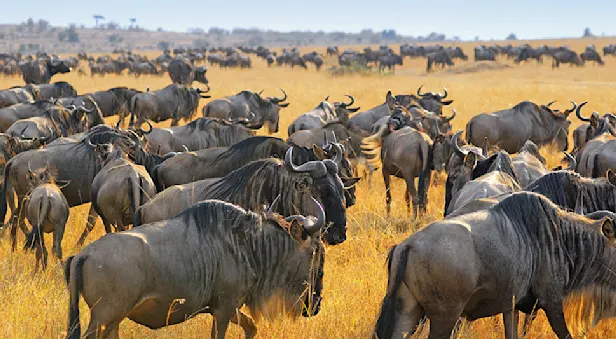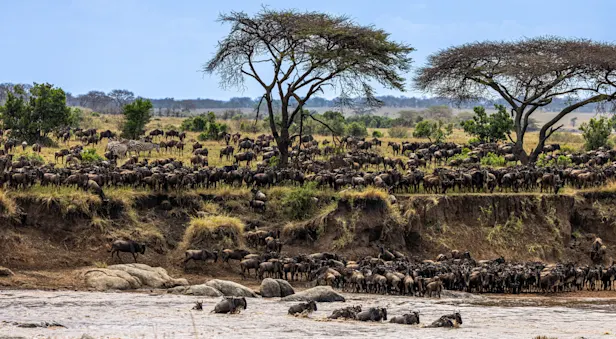What to Pack for an East Africa Safari
The following packing list contains general recommendations for an East Africa safari. If you are currently booked on a safari with Nat Hab, please consult your pre-departure materials for the most up-to-date packing list specific to your trip, as packing recommendations vary based on the season. You will receive these pre-departure materials 60-90 days before your departure.
Items indicated in color below are typically available in the Nat Hab Gear Store. Please note that due to global supply chain issues beyond our control, we cannot guarantee that every item will always be in stock.
Adventure Guidelines
A daypack/backpack to carry cameras and other items is handy while on wildlife drives and activities.
While on safari, it is suggested (although not required) that you do not wear bright or white-colored clothing, as it can sometimes spook the animals. In addition, army camouflage uniforms and hats are forbidden (although khaki is fine).
We recommend that you wear light-colored, lightweight clothing, especially in Tanzania, to reduce your chances of being bitten by tsetse flies.
We ask that you refrain from bringing hair dryers, irons, radios, excess clothing or toiletries, etc. All points of this adventure are quite casual, and we recommend that you keep your luggage down to the basics. Also, please remember not to pack your essentials in your checked luggage, in case it is delayed or lost by the airlines.
While on safari, many people choose to wear shorts and a T-shirt during the day and change to long-sleeved shirts and long pants in the evening, for warmth as well as protection from mosquitoes. Should you be particularly sensitive to the sun, a loose, long-sleeved cotton shirt is essential for wildlife drives during the day.
How to dress for different seasons:
— June through September – These months are usually dry, although you should always be prepared for unseasonable weather. Conditions on this adventure can range from warm, dry and dusty to quite cool evenings and mornings. Remember, just because it is Africa does not mean it is always warm. We recommend dressing in layers with a fleece pullover, jacket/windbreaker, gloves and hat during the winter months of June through September. This way, you can take off clothing as the sun warms throughout the day.
— October and December through March – These months are mostly dry with a slight chance of rain edging up to the short rains of November and the long rains of April and May. We recommend dressing in layers with a fleece pullover, jacket/windbreaker and lightweight clothing. This way, you can take off layers as the sun warms throughout the day. Conditions on this adventure can range from hot, dry and dusty to cool, overcast rain showers. We highly recommend you bring a lightweight rain jacket or poncho and rain pants, as occasional showers are likely.
— November and April/May – The short rains occur in November and the long rains in April/May. Conditions can range from hot, dry and dusty to daily downpours. Be prepared with lightweight clothing suitable for hot and sunny days. We highly recommend you bring a lightweight rain jacket or poncho and rain pants, as afternoon showers are likely.Due to the high elevation (7,000-8,000 feet), the temperature on the rim of the Ngorongoro Crater can range between 55° and 75°F during the day and can drop to as low as 40°F at night. When staying in the Ngorongoro Highlands, temperatures can get quite cold. We strongly recommend bringing a light jacket, sweater or fleece, a long pair of pants and something warm to sleep in. If you are especially sensitive to cooler weather, you may also want a hat and gloves. Some camps provide space heaters, but it’s also wise to be prepared with warm layers and warm pajamas. Temperatures at the bottom of the crater are much warmer than those at the rim.
Inside the Ngorongoro Crater, dust can be a nuisance. To avoid excessive contact, we recommend wearing long pants and a long sleeve shirt while on your wildlife drive, in addition to bringing a bandana or some kind of facemask to keep the dust off of your skin.
We advise protecting yourself against the strong sun by wearing a wide brim hat and using sunscreen.
Plastic grocery bags are banned in both Kenya and Tanzania, so you will not be allowed to bring them into either country. Fines may be levied if these are found in your possession by customs officials. Please keep this in mind as you are packing. Also, remove any duty free items that have been sealed in plastic bags and leave the bags on the plane.
The customs and culture of East Africa, especially in coastal areas and Zanzibar, are conservative. Revealing or very tight clothing should be avoided, however tank tops/sleeveless shirts are acceptable for women to wear while on safari, so please feel free to bring them.
Clothing
Lightweight neck gaiter (included in your pre-departure package)
—Provides sun, wind and/or dust protection.Silk, wool or polypropylene long underwear for layering (tops & bottoms)
Lightweight, “breathable,” waterproof rain jacket, rain pants & inexpensive rain poncho (not needed June through September)
1-2 sweaters, sweatshirts or fleece pullovers
— If traveling June through September, it is a good idea to bring two so that one can be worn if the other needs to be washed. During these months, evenings and early mornings can be very chilly, so warm layers are key.Lightweight, low-cut hiking/walking shoes
— If you plan to participate in nature walks, closed-toe shoes are required.Extra pair of shoes and/or sport sandals
— During the cooler months of June through September, you may want a second pair of comfortable closed-toe shoes as it can be quite cold, especially during wildlife drives. Sandals may still be worn while in camp, however you may decide to get by without them in order to save space in your luggage.
— During the warmer months of October through May, we find that Teva-type sandals can be very comfortable on wildlife drives, and are practical since they tend to dry quickly.2-4 pairs of long pants (or nylon, zip-off pants—practical for cool mornings and warmer afternoons)
Swimsuit (optional)
— Some of the camps have swimming pools.Sleepwear
Hat with brim (for sun protection)
Socks
— Moisture-resistant/moisture-wicking are preferred for safari walks and longer hikes. Smartwool is a comfortable brand.Undergarments
Polypropylene or silk thermal underwear—tops and bottoms (only needed June through September)
Additional Items
Cash
— For discretionary gratuities (you may want to bring envelopes for discreet presentation)
— For personal spending (souvenirs, Internet use or food and beverages not included in your trip fee)Binoculars
— Binoculars are definitely a must! We strongly suggest that each client bring his or her own pair of binoculars, as you will be using them continuously while on wildlife drives. If possible, we highly recommend investing in a good quality pair. Initially, the cost may be higher, but it definitely will enhance your wildlife viewing experience. You will get the most out of them if you practice using them at home and make a habit of having them with you regularly on the adventure. Waterproof binoculars work well, but are not required.Reusable water bottle (included in your pre-trip package)
—In our continuing effort to operate our adventures with as little impact on the environment as possible, you will receive a reusable water bottle (unless you opted out on your Booking Form) to take with you on your adventure. We will provide drinking water throughout the adventure for you to refill your bottle. By doing this, you will avoid using multiple disposable plastic bottles.Insect repellent and anti-itch ointment
— Repellent is provided at virtually all of our camps, so you only need to bring it if you wish to use a specific brand.
— Repellents containing DEET are the most effective against mosquitoes, but please be aware that DEET is a very strong ingredient which can damage plastics, clothing and equipment.Outlet adapter and/or power converter
Sunglasses (with U.V. filter and secure strap)
— In addition to being helpful for sun protection, sunglasses can also be useful eye protection on walks or drives in the bush.Headlamp or small flashlight
— Flashlights are provided at nearly all of our camps, but depending upon the number of travelers, there may only be one per tent. We recommend that each traveler bring a small but powerful flashlight (or headlamp) to have for personal use.Earplugs
Shampoo, conditioner & soap/body wash
— Only if you wish to use a specific brand. These items are provided free of charge at all of our accommodations.Toothbrush & paste
Deodorant
Brush or comb
Sunscreen & lip balm (at least SPF15)
— If your itinerary includes swimming or snorkeling in the ocean, please consider reef-safe sunscreens to protect the delicate underwater environment. Some brands include Coral Safe, Badger, Raw Elements and Blue Lizard.Prescription medications & favorite remedies
— For headaches, colds, upset stomach, skin irritations, diarrhea, etc.
— If you are prone to motion sickness you may want to bring your favorite remedy for small plane transfers.Electrolyte/flavor crystal packets (optional)
— Can be added to water to replace fluids in case of intestinal illness and/or enhance the taste to encourage hydration.Prescription glasses/contact lenses
Hand sanitizer and/or hand wipes
Battery-operated alarm clock/wristwatch
Reusable waterproof bags
— Several sizes for wet or dirty clothing and to protect camera equipment. Again, do not bring plastic grocery bags, as they are banned in Kenya and Tanzania.
Ultimate East Africa itineraries:
Due to the tropical climate in Uganda, it can rain at any time of the year on our gorilla safaris, however on most days there are also periods where the skies clear and the sun comes out. The mountainous areas are much cooler than lower elevations and nighttime temperatures can be chilly.
Face masks
—Gorillas, chimps and monkeys are highly susceptible to disease so masks may be recommended/required during some activities and/or while trekking to protect wildlife.
—High-quality masks such as N95, KN95, or 3-ply surgical masks offer the best protection.Waterproof rain jacket (with hood) and rain pants
—Waterproof (not just water-resistant) rain gear is essential as showers are unpredictable. You will be tracking gorillas in a rain forest where it can drizzle all day or, at times, rain down in buckets!Gardening or work gloves
—Important for protection from stinging nettles while on treks.
—Some lodges may have a stock of gloves for use by visitors, but they cannot be guaranteed so we recommend bringing your own.Sturdy, high-top, waterproof hiking boots
—Make sure your boots have good tread and ankle support and remember to break them in before your adventure, so you do not get blisters!Gaiters
—If you are booked on a custom extension in Rwanda, complementary gaiters are provided for gorilla trekking if staying at Five Volcanoes Boutique Hotel and Bisate Lodge. Other lodges may have a stock of gaiters for use by visitors, but they cannot be guaranteed so we recommend bringing your own.Hiking poles (optional)
—Walking sticks (one per person, carved out of wood) will be available for use while in Bwindi National Park.
—If you are bringing hiking poles, they must be able to fit in your check-in luggage, as you generally will not be allowed to carry them on the plane.
Header Credit: Melissa Scott
Witness the Great Migration on These East Africa Safaris

Tanzania’s Great Migration & Ngorongoro Crater
Witness one of nature's most exhilarating spectacles: thousands of wildebeest and zebra making their annual trek across the Serengeti! Itineraries custom-designed to follow the herds.

























